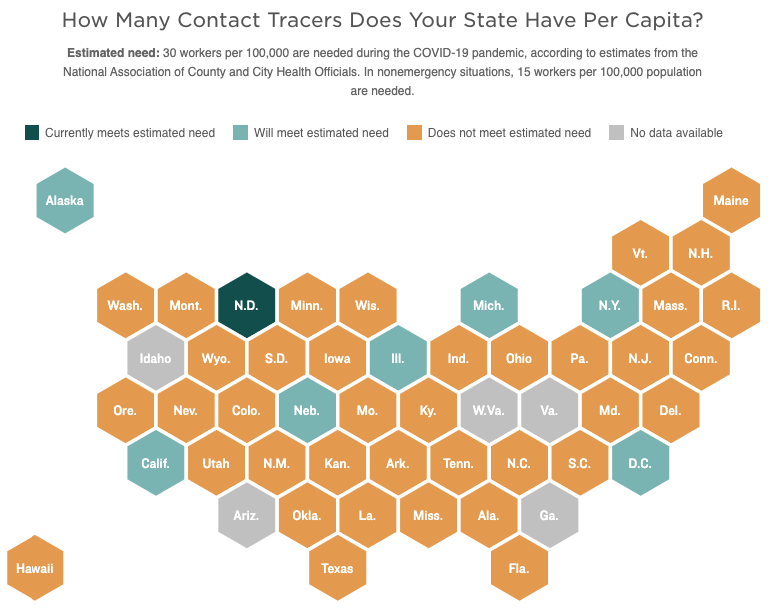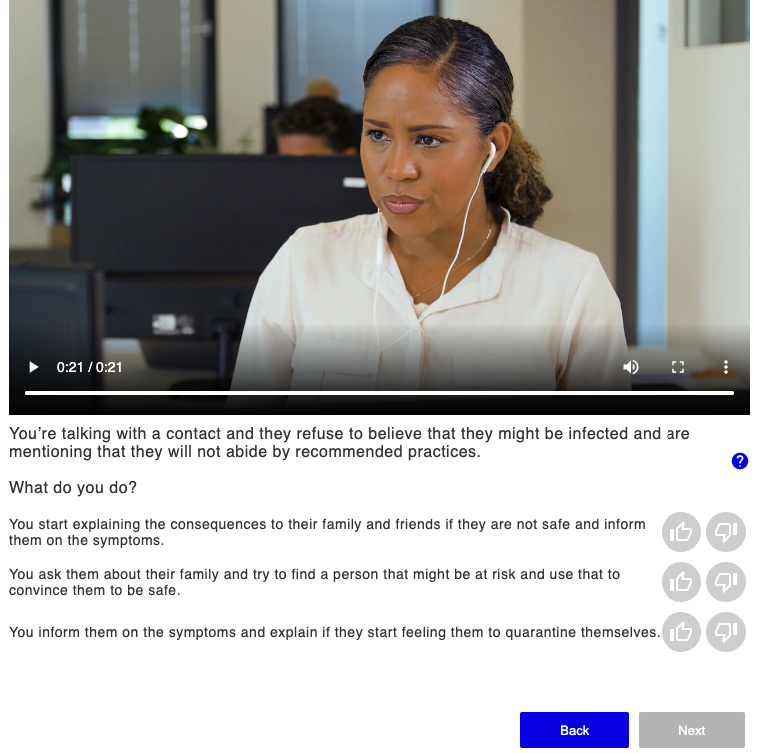Hiring COVID-19 contact tracers is a challenging task. You have to hire a lot of people in a short period of time, and for a job that has never existed on this scale before.
Contact tracers are critical to safely reopening the economy, so you are under pressure to recruit and onboard enough people, fast.
So if you’re wondering where to start or how to improve your contact tracer hiring process, read on!
What’s in?
- Identify essential skills
- Hire locally
- Design a fast hiring process
- Use online pre-employment assessments to shortlist candidates
- Use situational judgement tests
- Ask relevant interview questions
- Provide proper onboarding
Like what you see?
Don’t miss out. Subscribe to our quarterly digest to get the latest TA and TM resources delivered right to your inbox.
1. Identify essential skills
Before you start designing your recruitment process for hiring contact tracers and crafting your job postings, spend enough time on identifying the essential skills the contact tracers really need to do the job.
COVID-19 contact tracing generally doesn’t require a background in public health or healthcare. And while it’s useful that a candidate has the basic knowledge about COVID-19 and how it spreads, you will be providing training on that to the new hires anyway.
Instead, focus on broader employability skills that go beyond experience, knowledge, and qualifications. These skills are transferable, that’s why you don’t have to shy away from considering candidates from different backgrounds and industries.
So what are some of the skills and competences contact tracers should have and why?
- Communication and interpersonal skills – responding appropriately to the needs, feelings, and capabilities of different people in different situations
- Empathy and cultural competence – showing empathy to individuals during a time of crisis and distress, interacting effectively with people of different cultures and socio-economic backgrounds without judgement
- Organizational skills – prioritizing tasks, staying focused and productive in a remote work environment, multitasking and completing cases in a timely manner
- Critical thinking – asking the right questions, correctly evaluating the information that someone is providing and drawing the right conclusions
- Strong work ethic – having a professional attitude, readiness to perform to the best of the abilities, willingness to work in shifts
Additional language skills are another thing to consider, especially if the contact tracers will be working with people with a migrant background, e.g. Spanish-speaking.
After you’ve identified the necessary skills, make sure to not only list them in your job description but also put them in the context of the contact tracing role.
2. Hire locally
Contact tracers’ main task is to interview and interact with people potentially exposed to COVID-19. To do that effectively, they have to build trust with the individuals they’re talking to and be perceived as allies.
It is essential that the contact tracers understand the communities they’re working with. That’s why, even though they mostly work remotely, you should aim to hire locals for your contact tracer openings. Local people already have certain insights into the lives of people in the community and can more easily relate to and address their worries, fears, and problems.
To attract local candidates, advertise your contact tracer roles on local channels such as regional job boards or Facebook groups.

A majority of US states do not meet the estimated contact tracer needs at the moment and they need to ramp up their hiring effort. Check your state in an interactive map here.
3. Design a fast hiring process
Having enough trained contact tracers is key to a safe reopening of the economy, so you need to proceed fast with recruiting. With millions of Americans having lost their jobs since mid-March 2020, you will have a lot of applicants.
How can you manage this?
You have to develop an efficient process and automate what you can. For example, you can send automated emails based on candidate status and let shortlisted applicants self-schedule interviews.
In addition, consider automating parts of your pre-selection process. Instead of phone screening, you can ask candidates to answer a few questions in a one-way video interview, which will allow you to view more candidates in a shorter period of time.
If you want to hire even faster, have a look into a database of pre-qualified contact tracers and you can move straight to interviewing the best candidates.
In case you prefer to pre-select candidates yourself, using online assessments can help you cut the time to hire in half. This brings us to the next point.
4. Use online pre-employment assessments to shortlist candidates
Online pre-employment assessments are used in recruitment to measure candidates’ abilities, tendencies, and behaviors. They enable you to evaluate the relevant skills regardless of their previous experience. This is especially important for the contact tracer roles, as you will be hiring candidates from different industries. What’s more, by collecting relevant data about the candidate’s skills, you can make data-driven hiring decisions and reduce hiring bias.
Cognitive ability assessments are considered a good predictor of job performance across job levels. This assessment measures candidates’ analytical and logical reasoning skills, so you can evaluate their critical thinking and organization.
Using a personality questionnaire helps you uncover whether your applicants have the right traits and competencies to become contact tracers. This is done by comparing the questionnaire results to the pre-set benchmarks.
You can also include a short computer proficiency test with multiple-choice questions to your online assessment experience to make sure that your candidates have the basic computer skills.
Use the assessments at the beginning of the recruitment process to shortlist strong candidates early on. Don’t forget to ask additional questions, for instance, if the candidate is allowed to work in your country or where they are located.
5. Use situational judgement tests
A situational judgement test (SJT) is a behavioral assessment that presents candidates with realistic on-the-job scenarios in a written, image, or video format. They are presented with several options and they choose the best and worst responses to the situations.
The goal of conducting an SJT is twofold. The assessment lets you gauge candidates’ behavior and reactions in situations they could encounter in the role and they also show candidates what the job is about. They provide a realistic job preview, helping the applicants to decide whether or not they see themselves doing the job.
For example, contact tracers often need to deal with people who are angry and unwilling to answer questions. In such situations, they should stay calm, patient, and look for ways to get the necessary information. That could be one of the scenarios for your contact tracer SJT.
Creating your own video-based SJTs is budget- and time-consuming. Consider utilizing image- or text-based scenarios in your selection process or make use of a free ready-made contact tracer SJT.

This is an example of the video-based SJT from ContactTracers.com.
6. Ask relevant interview questions
While online assessments and SJTs are very useful in the pre-selection process, you should also interview the shortlisted applicants to ensure that they have what it takes to be a contact tracer.
You’ve identified the essential skills, competencies, and behaviors your ideal candidates should have and your interview structure and questions should help you verify it.
Choose interview questions that directly relate to the skills you’re looking for in your candidates. Here are a few examples:
- Can you describe a situation where you found yourself in a new or unfamiliar setting with people you didn’t know? What happened? How did you feel during the situation? – This question will help you evaluate candidates’ interpersonal skills and empathy.
- Can you share an example of when you were pushed to raise the bar? What was the situation? What did you do? What was the outcome? – You can get insights into candidates’ work ethic by asking this question.
- Can you share an example of a situation where you had many resources you had to use to complete a project? What did you do? – Ask this question to find out more about your applicants’ organizational skills and critical thinking.
You can prepare interview scorecards to establish an objective assessment of relevant criteria. Building a structured interview process will help you make consistent hiring decisions and minimize the risk of unconscious bias.
7. Provide proper onboarding
Once you’ve successfully hired a contact tracer, your goal is to get them productive as fast as possible. That’s what the onboarding process is for.
Make sure to complete their paperwork before they start working. If you’re onboarding your new hires remotely, create digital versions of all the forms they need to sign, as well as of other common employee documents.
Check with the new contact tracers if they have the hardware and software they need to do the job. Help them set up their accounts.
Your new hires will need an introduction to the workflow and to the tools they will be using so you should provide training for these, as well as create documents with FAQs they can always refer to if they have questions.
Setting expectations is a critical part of the onboarding process. Your newly hired contact tracers need to know what their goals and KPIs are in order to work effectively. Take time to explain to them where you expect them to start and what you expect them to achieve in the first week, first month, and first 90 days.
If you already have contact tracers working for you, you can pair them up with your new hires to guide them at the beginning.
Without proper onboarding and initial training, you’re risking that your new contact tracers will feel lost and productivity will suffer. On the other hand, a solid onboarding process, whether remote or onsite, will drive employee engagement right from the start and help new hires do their job well from the get-go.
Over to you
When hiring COVID-19 contact tracers, you need to pay extra attention to your candidates’ transferable skills such as critical thinking, organizational skills, and communication and interpersonal skills. Build a recruitment process that helps you assess candidates beyond just their resumes and based on their actual skills.
After you’ve successfully hired new contact tracers, provide them with a good, thorough onboarding experience to prepare them for the job.
Having a fast and effective recruitment and onboarding process for your contact tracer roles helps you make sure that the newly hired contact tracers can start contributing to protecting your community right away.

